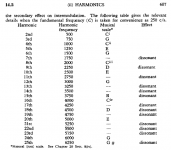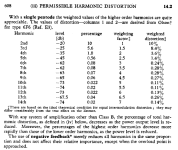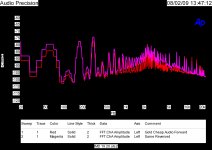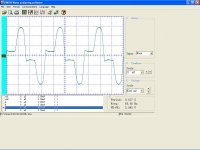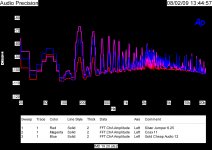Ok, will do.IF you will ONLY Google, you can learn more about 7th harmonic and its 'problem' with the musical scale than anything that I can say here.
Eric.
Back in the days when I had a V-15 I wired my turntable with the direction of L and R cables reversed WRT each other and could never get center imaging correct.
One day a dealer showed me the sonic effect of reversing the direction of one line level interconnect and instantly I worked out what was wrong with my TT.
That night I modified my TT so that both channels were using the same type of cable running in the same directions and VOILA....center imaging became correct without using balance control that never cured the problem properly anyway.
Do cable low level signal effects become significant at low levels signals like phono feeds ?.
Eric.
One day a dealer showed me the sonic effect of reversing the direction of one line level interconnect and instantly I worked out what was wrong with my TT.
That night I modified my TT so that both channels were using the same type of cable running in the same directions and VOILA....center imaging became correct without using balance control that never cured the problem properly anyway.
Do cable low level signal effects become significant at low levels signals like phono feeds ?.
Eric.
As far as Kirkwood Rough is concerned and his library: I pulled the 1941 edition of the 'Radiotron Designers Handbook' to page 43 or so, and showed Kirkwood that 7th harmonic distortion was taboo then, as it is today. They had a special statement about it is being completely unmusical and that it MUST be designed below audibility. Check it out, all!
available from pmillett.com
Attachments
IF you will ONLY Google, you can learn more about 7th harmonic and its 'problem' with the musical scale than anything that I can say here.
What has the 7th harmonic to do with the musical scale?
If there's a "problem" with the 7th harmonic and the musical scale,then virtually every instrument out there has a "problem" with the musical scale.
What, when you hit middle C on a piano the piano just emits a nice pure 261.6 Hz tone?
Have we been doing it wrong all these years? Should music only be played using pure tones corresponding to the notes on the page, instead of instruments which produce gobs of harmonics, including the 7th?
se
John, thanks for posting this.
This describes amplifiers and systems that get 'shouty' as level is increased.
The fact that 7th harmonic is dissonant in the standard western musical scale is important.
How do our 'Eastern' and 'Asian' brethren perceive amplification systems playing 'Eastern' and 'Asian' music ?.
With any system of amplification other than class B, the percentage of total harmonic distortion...decreases as the power output level is reduced.
Moreover the percentages of the highest order harmonics decrease more rapidly than those of the lower order harmonics as the power is reduced.
The use of negative feedback merely reduces the level of all harmonics in the same proportion and does not reduce their relative importance, except when the overload point is approached.
This describes amplifiers and systems that get 'shouty' as level is increased.
The fact that 7th harmonic is dissonant in the standard western musical scale is important.
How do our 'Eastern' and 'Asian' brethren perceive amplification systems playing 'Eastern' and 'Asian' music ?.
The problem is that artificially produced 7th's do not belong.What has the 7th harmonic to do with the musical scale?
If there's a "problem" with the 7th harmonic and the musical scale,then virtually every instrument out there has a "problem" with the musical scale.
What, when you hit middle C on a piano the piano just emits a nice pure 261.6 Hz tone?
Have we been doing it wrong all these years? Should music only be played using pure tones corresponding to the notes on the page, instead of instruments which produce gobs of harmonics, including the 7th?
se
The western musical scale is not regular and therein lies the problem when replay gear adds tones that should NOT be there.
Relative levels of harmonics defines timbre and any change in timbre is usually loudly apparent, especially any addition of the 7th which is a foreigner as Langsford-Smith and JC assert.
Eric.
The problem is that artificially produced 7th's do not belong.
Ideally, NO artificially produced harmonics belong. So what makes the 7th particularly special?
The western musical scale is not regular and therein lies the problem when replay gear adds tones that should NOT be there.
If the western music scale is the reference, then virtually every instrument out there adds tones that should NOT be there.
Relative levels of harmonics defines timbre and any change in timbre is usually loudly apparent, especially any addition of the 7th which is a foreigner as Langsford-Smith and JC assert.
It's only a "foreigner" when one looks at it with respect to the western music scale which is based on pure tones. In which case all harmonics are "foreign" as well as any instrument which doesn't produce anything but pure tones.
When looked at from the perspective of the actual instruments we use to perform music, the 7th is no foreigner at all.
So this idea that the 7th is particularly special is rather absurd if you ask me.
se
Ideally, NO artificially produced harmonics belong. So what makes the 7th particularly special?
If the western music scale is the reference, then virtually every instrument out there adds tones that should NOT be there.
It's only a "foreigner" when one looks at it with respect to the western music scale which is based on pure tones. In which case all harmonics are "foreign" as well as any instrument which doesn't produce anything but pure tones.
When looked at from the perspective of the actual instruments we use to perform music, the 7th is no foreigner at all.
So this idea that the 7th is particularly special is rather absurd if you ask me.
se
Looks like according to the Harmonics chart a few posts back, it shows that the 7th as the first harmonic that doesn't fall on the natural (Western) scale (laying between G'' and C''').
.
Looks like according to the Harmonics chart a few posts back, it shows that the 7th as the first harmonic that doesn't fall on the natural (Western) scale (laying between G'' and C''').
Yes.
But so what?
Most any instrument you care to name produces 7th harmonics. And 9th, and 11th, and 13th, 14th, 15th, and so on.
But I don't see anyone saying these instruments sound like crap because they produce 7th harmonics or any other harmonics that are dissonant with the music scale.
Maybe those who insist on only listening to music made with pure tones would have a problem with these harmonics. But beyond that, I don't see any particular merit to the argument.
se
7th can't be 'tempered' into the scale.
Quote without comment: re. piano tone "Even if the hammer were perfectly hard, the seventh harmonic could be eliminated entirely by allowing the hammer to strike the string at a point a seventh of its length from one end, this being a node for the vibration in question. ... " p. 92 'Science and Music' Sir James Jeans 1937
And guess how musical instruments are made?
Quote without comment: re. piano tone "Even if the hammer were perfectly hard, the seventh harmonic could be eliminated entirely by allowing the hammer to strike the string at a point a seventh of its length from one end, this being a node for the vibration in question. ... " p. 92 'Science and Music' Sir James Jeans 1937
And guess how musical instruments are made?
Back in the days when I had a V-15 I wired my turntable with the direction of L and R cables reversed WRT each other and could never get center imaging correct.
Do cable low level signal effects become significant at low levels signals like phono feeds ?.
Eric.
Gross deviation of the sound field at the listening position is a testable hypothesis. After returning to cable directionality we can discuss the -135dB sevenths again, while everyone agrees no stylus ever made has any hope of actually tracking an LP acurately at high frequencies.
7th can't be 'tempered' into the scale.
Nor can the 9th, 11th, 13th, 14th, 15th, etc.
Quote without comment: re. piano tone "Even if the hammer were perfectly hard, the seventh harmonic could be eliminated entirely by allowing the hammer to strike the string at a point a seventh of its length from one end, this being a node for the vibration in question. ... "
Reading on...
This would, however, leave the ninth and eleventh harmonics fairly strong, their positional factors being 0.60 and 0.30 respectively.
And to understand why they might want to suppress the 7th harmonic on a piano, look at the table on the previous page. It gives the energy distribution for the harmonics between the string being plucked and the string being struck.
When plucked, the distribution follows the harmonic order, i.e. the energy diminishes as the order goes up. When struck, the distribution is even across the orders.
That's also why the felt the hammers:
This [felt] reduces the energy which goes into the higher harmonics, and so avoids the harsh jangle of sound represented in the bottom column of the above table.
And of course this only relates to how piano makers want pianos to sound. The hammered dulcimer produces considerable amounts of higher harmonics yet it is still capable of producing beautiful music.
And guess how musical instruments are made?
Gee, I don't know John. I'd imagine pianos are made like pianos, oboes are made like oboes, violins are made like violins, and so on.
What's your point?
se
Gross deviation of the sound field at the listening position is a testable hypothesis. After returning to cable directionality we can discuss the -135dB sevenths again, while everyone agrees no stylus ever made has any hope of actually tracking an LP acurately at high frequencies.
Scott,
You've seen this before the IM from 150 mv or so of 93.75 and 96 khz sine waves sourced by 100 ohms and terminated by a high impedance comparison of input to output of an RCA cable with cosmetic gold plated connectors.
The 60 hz noise and harmonics don't really change but the IM does by about 10 db with direction.
Yes it is at a very low level. But it is nicely repeatable.
I've also attached just for no reason a shot of the input current to a 200 wpc class AB amplifier at full output. I just finished mod'ing my bench isolated AC outlet with a built in current monitor. (100mv/A FYI)
Measuring the source impedance of outlets around my place they vary from .085 to .310 ohms. An IEC cord that came with a piece of gear was .185 ohms.
ES
Attachments
Scott,
You've seen this before the IM from 150 mv or so of 93.75 and 96 khz sine waves sourced by 100 ohms and terminated by a high impedance comparison of input to output of an RCA cable with cosmetic gold plated connectors.
The 60 hz noise and harmonics don't really change but the IM does by about 10 db with direction.
Yes it is at a very low level. But it is nicely repeatable.
ES
And again I repeat, not one measurement/experiment to explain the results within normal bounds (i.e. defective construction). As you post it here there is virtually no way for anyone to repeat your experiment. The 60hz does look 5dB off and the mess looks like it could include all kinds of lab trash as well.
Without further investigation in such a case of mis-termination I would expect moving the cable 2 or 3 inches in a noisy environment could cause the same effect.
Last edited:
And again I repeat, not one measurement/experiment to explain the results within normal bounds (i.e. defective construction). As you post it here there is virtually no way for anyone to repeat your experiment.
No, details are not posted here, anyone can look at the November 2009 Audioxpress for complete construction details and parts lists of the test device I built to produce these results.
I don't exactly hide anything about it. J.J. has mentioned he has stopped by and seen it so I will drop his name. (Oh yeah I did do multiple runs switching back and forth and kept getting the same results)
I have attached another image this time of 3 different cables so you can see what changes and what is lab trash.
Any time you want to stop by, let me know. I will eventually get around to improving the instrument and at that time I'll make more than one.
ES
Attachments
Last edited:
No, details are not posted here, anyone can look at the November 2009 Audioxpress for complete construction details and parts lists of the test device I built to produce these results.
I don't exactly hide anything about it. J.J. has mentioned he has stopped by and seen it so I will drop his name. (Oh yeah I did do multiple runs switching back and forth and kept getting the same results)
I have attached another image this time of 3 different cables so you can see what changes and what is lab trash.
Any time you want to stop by, let me know. I will eventually get around to improving the instrument and at that time I'll make more than one.
ES
30db at 180Hz looks like a huge difference in shielding/grounding. That has nothing to do with the 96/93.5 input or directionality in the philosophical sense.
30db at 180Hz looks like a huge difference in shielding/grounding. That has nothing to do with the 96/93.5 input or directionality in the philosophical sense.
Yes it is. It has to do with shielding and loop area. The best of that lot was a 6.25 silver wire jumper. The worst was a coil of braided 2m coax.
Cable Directionality
This is a hot-button topic for me, having worked years ago in high-end stereo stores to put myself through college and afterwards. There are some serious scam artists who put this claim forth as gospel, but cannot themselves tell the difference, as verified by myself in tests (and verified by the purveyors in after-hours drinking sessions). One memorable test with a NAIM rep in which he claimed to hear the speaker cable being reversed (it has arrows on it for a reason!!!), and after I swapped it end for end (NOT) he claimed it was then "MUCH BETTER, THANK YOU!" comes to mind. I still cannot buy NAIM eq, even though some of it is just fine.
Out of respect to the claimants, I have spent an inordinate amount of time attempting to give claims of this nature benefit of the doubt, and I have thought of a way that line-level shielded cable directionality could be caused. Keep in mind, this is ONLY for siamesed line-level cables. Directional speaker cables (other than MAYBE litz types) make no sense no matter how you approach the idea. Having also worked at Madison Wire in Worcester, MA, I can tell you from experience that there is no definite orientation to adjacent lays of siamesed zip-cord cables, so how could a directionality be established? Which direction is which? If there is a grain orientation with diodic effects, it would be measurable as distortion, as many others have stated.
If the preposition is that there is ACTUALLY a difference in a cable's performance in ANY respect when driven and loaded parallel or anti-parallel, it HAS to be due to an axial asymmetry.
Analyzing the structure of a cable for non-axially symmetrical factors, the only one that comes to mind is shield lay in the case of a cable with a shield consisting of a uni-directionally laid helical series of wires (not woven braid or foil). I know of some otherwise very high quality cables like Mogami multi-channel snakes, where each twisted pair has a shield of this nature.
In this case, and assuming that the individual strands actually oxidize (which they will), and ohmically decouple from the adjacent strands, the shield will then not approximate a cylinder, it will create a linear coil with a finite external field when current flows. If this is the case, depending on the orientation of the helix on adjacent cables, there could be mutual coupling between these two linear solenoids' external fields. This coupling would be maximized when the helixes were in the same orientation, and potentially nulled (depending on the pitch of the helix) when they were opposite orientation.
I would be interested in seeing tests of line-level cable with different shielding types to see if this is indeed the case. I would do it but for time...
Howard Hoyt
CE - WXYC-FM 89.3
UNC Chapel Hill
www.wxyc.org
1st on the Internet
Yes it is. It has to do with shielding and loop area. The best of that lot was a 6.25 silver wire jumper. The worst was a coil of braided 2m coax.
This is a hot-button topic for me, having worked years ago in high-end stereo stores to put myself through college and afterwards. There are some serious scam artists who put this claim forth as gospel, but cannot themselves tell the difference, as verified by myself in tests (and verified by the purveyors in after-hours drinking sessions). One memorable test with a NAIM rep in which he claimed to hear the speaker cable being reversed (it has arrows on it for a reason!!!), and after I swapped it end for end (NOT) he claimed it was then "MUCH BETTER, THANK YOU!" comes to mind. I still cannot buy NAIM eq, even though some of it is just fine.
Out of respect to the claimants, I have spent an inordinate amount of time attempting to give claims of this nature benefit of the doubt, and I have thought of a way that line-level shielded cable directionality could be caused. Keep in mind, this is ONLY for siamesed line-level cables. Directional speaker cables (other than MAYBE litz types) make no sense no matter how you approach the idea. Having also worked at Madison Wire in Worcester, MA, I can tell you from experience that there is no definite orientation to adjacent lays of siamesed zip-cord cables, so how could a directionality be established? Which direction is which? If there is a grain orientation with diodic effects, it would be measurable as distortion, as many others have stated.
If the preposition is that there is ACTUALLY a difference in a cable's performance in ANY respect when driven and loaded parallel or anti-parallel, it HAS to be due to an axial asymmetry.
Analyzing the structure of a cable for non-axially symmetrical factors, the only one that comes to mind is shield lay in the case of a cable with a shield consisting of a uni-directionally laid helical series of wires (not woven braid or foil). I know of some otherwise very high quality cables like Mogami multi-channel snakes, where each twisted pair has a shield of this nature.
In this case, and assuming that the individual strands actually oxidize (which they will), and ohmically decouple from the adjacent strands, the shield will then not approximate a cylinder, it will create a linear coil with a finite external field when current flows. If this is the case, depending on the orientation of the helix on adjacent cables, there could be mutual coupling between these two linear solenoids' external fields. This coupling would be maximized when the helixes were in the same orientation, and potentially nulled (depending on the pitch of the helix) when they were opposite orientation.
I would be interested in seeing tests of line-level cable with different shielding types to see if this is indeed the case. I would do it but for time...
Howard Hoyt
CE - WXYC-FM 89.3
UNC Chapel Hill
www.wxyc.org
1st on the Internet
- Status
- Not open for further replies.
- Home
- Member Areas
- The Lounge
- John Curl's Blowtorch preamplifier part II
